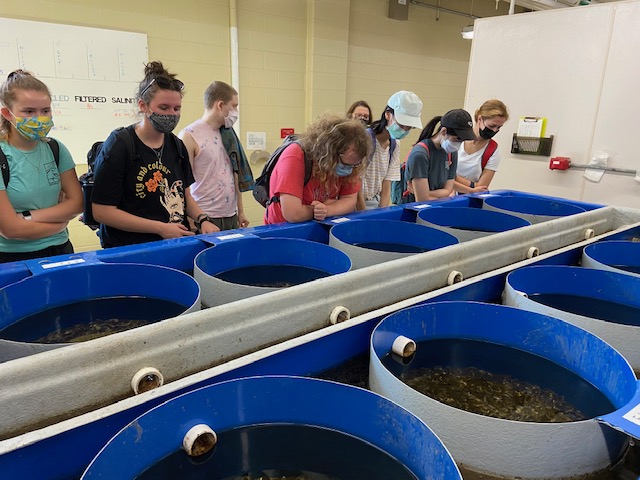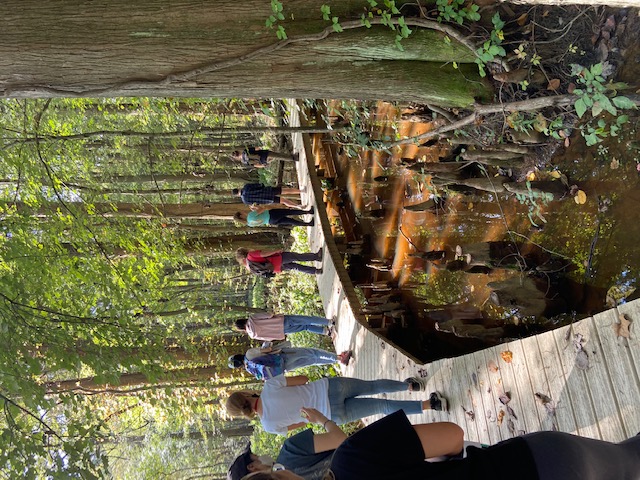Students in Jennifer Gunnulfsen’s Ecosystem Health and Protection (ENST333) course in the College of Agriculture and Natural Resources (AGNR).
Students in Jennifer Gunnulfsen’s Ecosystem Health and Protection (ENST333) course in the College of Agriculture and Natural Resources (AGNR) at the University of Maryland, toured the Chesapeake Biological Lab in October, and had the opportunity to engage with renowned aquatic toxicologist Dr. Carys Mitchelmore.
The Chesapeake Biological Lab (CBL) in Solomons, Md. is located on the Patuxent River right where it intersects the Chesapeake Bay. It is part of the University of Maryland Center for Environmental Science (UMCES), and hosts a variety of research related to the health of the Bay as well as the aquaculture industry, including current studies on conditions or factors that may affect oyster spat settlement rates.
“Dr. Mitchelmore gave us a tour of their grounds, oyster hatchery and lab, so she talked a lot about the work they do with the oysters -- they do research on some of the ideal conditions under which individual oysters settle onto the bottom substrate,” said Gunnulfsen, a lecturer in the Environmental Science & Technology Dept. who has been teaching the course for three years. “But she also talked about other work that she has been part of, and that was really the point -- I wanted the students to hear about active work that’s currently being done, hear from someone who is doing the work, get the visual and what it looks like to see Bay research being done.”
 Mitchelmore’s other projects include tracking toxic chemicals and their effects on various aquatic species, including current research on how sunscreens may affect corals. “She made it sound very exciting, a bit like a mystery -- what is responsible for impacting these species? We have to go back and see what the toxicity levels are that might be affecting them,” Gunnulfsen said. “It gave the students a good perspective on the challenges that toxicologists face when trying to determine the reason an ecosystem or species might be impacted.”
Mitchelmore’s other projects include tracking toxic chemicals and their effects on various aquatic species, including current research on how sunscreens may affect corals. “She made it sound very exciting, a bit like a mystery -- what is responsible for impacting these species? We have to go back and see what the toxicity levels are that might be affecting them,” Gunnulfsen said. “It gave the students a good perspective on the challenges that toxicologists face when trying to determine the reason an ecosystem or species might be impacted.”
As part of the trip, the class was also able to stop at the Battle Creek Cypress Swamp in Prince Frederick, Md. on the return ride to experience this unique ecosystem. The wetland is home to one of the northernmost locations of natural bald cypress trees in North America, according to the Department of Natural Resources.
“We talk about the systems and functions of wetlands, so it was terrific to actually stop and see one,” Gunnulfsen said. The class time itself is spent learning about different ecosystems, their characteristics, and the criteria for ecosystem health - how to measure that criteria and what challenges a scientist may face.
“When we discuss these topics in the class, the Chesapeake Bay is incorporated through the whole semester,” she said. “It’s a local, unique ecosystem, and you can really see the dynamics of ecosystem health playing out.” 
Twelve of the 15 students enrolled in the class were able to attend the field trip, most of whom are juniors and seniors, said Gunnulfsen. “They all wanted to go. They’re environmental science and technology majors, so they are interested and they really want these opportunities for learning outside of the classroom. They’re engaged and excited,” she said.
“They’re undergraduates, but these experiences make really good connections between what they do in the classroom and what they might do later in life with that and what the possibilities are. It’s a solid taste of the daily work life for a research scientist.”
This field trip was supported with funding from the AGNR Strategic Initiative for Healthy Watersheds and the Chesapeake Bay.